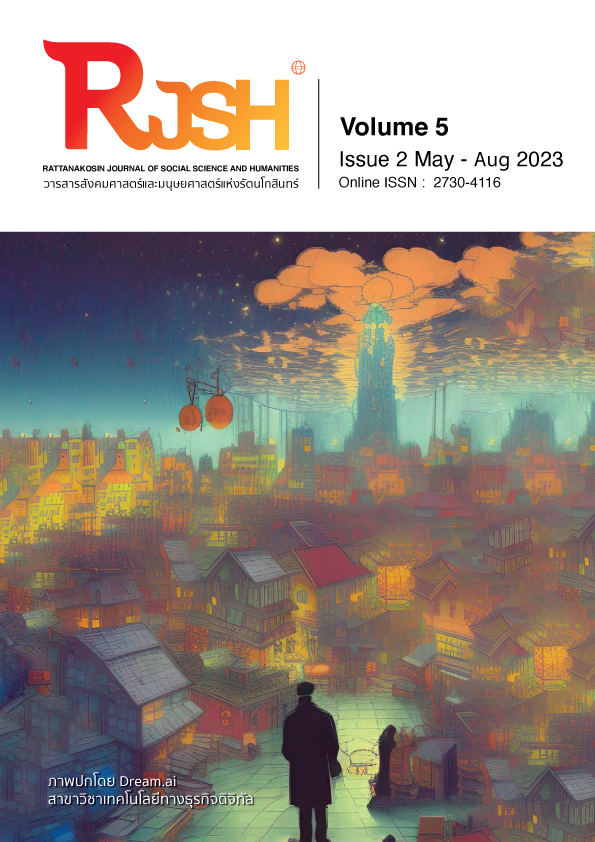A Survey Study of the Satisfaction of High-School Matthayomsuksa VI Students With an Original Version of Vocabulary Exercises Designed From the Grammar-Translation Method
Main Article Content
Abstract
The primary objective of this research was to examine the level of satisfaction among high-school Matthayomsuksa VI students at Panyaworakun School with an original set of vocabulary exercises developed based on the Grammar-Translation Method. The participants involved in this study consisted of 228 students enrolled in Class 6/1, 6/3, 6/5, 6/6, 6/7, 6/8, and 6/9 during the first semester of the academic year 2022 at Panyaworakun School. To assess the students’ satisfaction with the aforementioned vocabulary exercises, a questionnaire was utilized as the data collection instrument.
The questionnaire was specifically designed to gather information regarding the students’ contentment with the original version of vocabulary exercises. The data obtained from the questionnaire were analyzed using various statistical measures, including frequency, percentage, mean, and standard deviation. The findings of the research indicated that the entire cohort of 228 high-school Matthayomsuksa VI students, across all seven classes, expressed a high level of satisfaction with the original version of vocabulary exercises. This outcome aligns with the research hypothesis, further confirming the positive reception of the exercises among the students.
Article Details

This work is licensed under a Creative Commons Attribution-NonCommercial-NoDerivatives 4.0 International License.
The content within the published articles, including images and tables, is copyrighted by Rajamangala University of Technology Rattanakosin. Any use of the article's content, text, ideas, images, or tables for commercial purposes in various formats requires permission from the journal's editorial board.
Rajamangala University of Technology Rattanakosin permits the use and dissemination of article files under the condition that proper attribution to the journal is provided and the content is not used for commercial purposes.
The opinions and views expressed in the articles are solely those of the respective authors and are not associated with Rajamangala University of Technology Rattanakosin or other faculty members in the university. The authors bear full responsibility for the content of their articles, including any errors, and are responsible for the content and editorial review. The editorial board is not responsible for the content or views expressed in the articles.
References
Alimova, M. I. q. (2022). Grammar translation method in teaching linguistics. Scientific Progress, 3(3), 394-396.
Anderson, N. J. (1999). Exploring second language reading issues and strategies. Heinle & Heinle Publishers.
Best, J. W. (1983). Research in education. Prentice Hall of India Private.
Elmayantie, C. (2015). The use of grammar translation method in teaching English. Journal on English as a Foreign Language, 5(2), 125-132.
Khan, A. B., Mansoor, H. S. & Manzoor, S. (2015). The effectiveness of grammar translation method in teaching and learning of English language at intermediate level. International Journal of Multidisciplinary Research and Modern Education (IJMRME), 1(1), 629-633.
Krejcie, R. V., & Morgan, D. W. (1970). Determining sample size for research activities. Educational and Psychological Measurement, 30(3), 607-610.
Milawati. (2019). Grammar translation method: Current practice in EFL context. Indonesian Journal of English Language Teaching and Applied Linguistics, 4(1), 187-196.
Natsir, M. & Sanjaya, D. (2014). Grammar translation method (GTM) versus communicative language teaching (CLT); A review of literature. International Journal of Education and Literacy Studies, 2(1), 58-62.
Sophitthammakun, T. (2018). Using the vocabulary exercises for solving the students’problem of inability to remember the words and surveying the students’ opinions with the vocabulary exercises. Proceedings of the 8th PIM National Conference (pp.103-116). Panyapiwat Institute of Management.
Usman, A. H. (2015). Teaching vocabulary through grammar translation method. EDUKASI - Jurnal Pendidikan, 13(2), 299-312.


